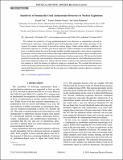Sensitivity of Seismically Cued Antineutrino Detectors to Nuclear Explosions
Author(s)
Carr, Rachel; Dalnoki-Veress, Ferenc; Bernstein, Adam
DownloadPhysRevApplied.10.024014.pdf (458.8Kb)
PUBLISHER_POLICY
Publisher Policy
Article is made available in accordance with the publisher's policy and may be subject to US copyright law. Please refer to the publisher's site for terms of use.
Terms of use
Metadata
Show full item recordAbstract
We evaluate the sensitivity of large gadolinium-doped water detectors to antineutrinos released by nuclear-fission explosions, using updated signal and background models and taking advantage of the capacity for seismic observations to provide an analysis trigger. Under certain realistic conditions, the antineutrino signature of a 250-kton pure-fission explosion could be identified several hundred kilometers away, in a detector about the size of the largest module currently proposed for a basic physics experiment. In principle, such an observation could provide rapid confirmation that the seismic signal coincided with a fission event, possibly useful for international monitoring of nuclear-weapon tests. We discuss the limited potential for seismically cued antineutrino observations to constrain fission yield, differentiate pure fission from fusion-enhanced weapon tests, indicate that the seismic evidence of an explosion had been intentionally masked, or verify the absence of explosive testing in a targeted area. We conclude that advances in seismic monitoring and neutrino physics have made the detection of explosion-derived antineutrinos more conceivable than previously asserted, but the size and cost of sufficiently sensitive detectors continue to limit applications.
Date issued
2018-08Department
Massachusetts Institute of Technology. Laboratory for Nuclear ScienceJournal
Physical Review Applied
Publisher
American Physical Society
Citation
Carr, Rachel et al. "Sensitivity of Seismically Cued Antineutrino Detectors to Nuclear Explosions." Physical Review Applied 10, 2 (August 2018): 024014 © 2018 American Physical Society
Version: Final published version
ISSN
2331-7019